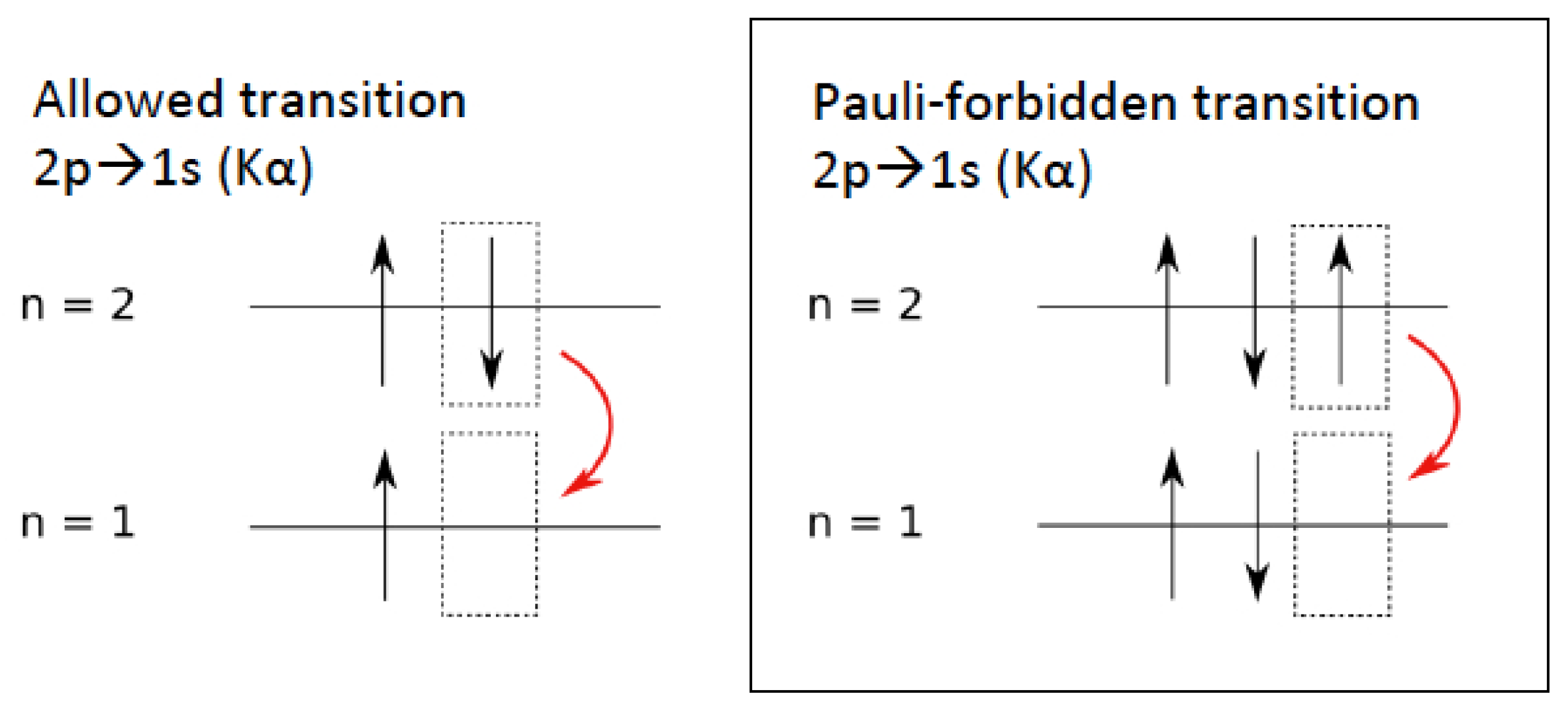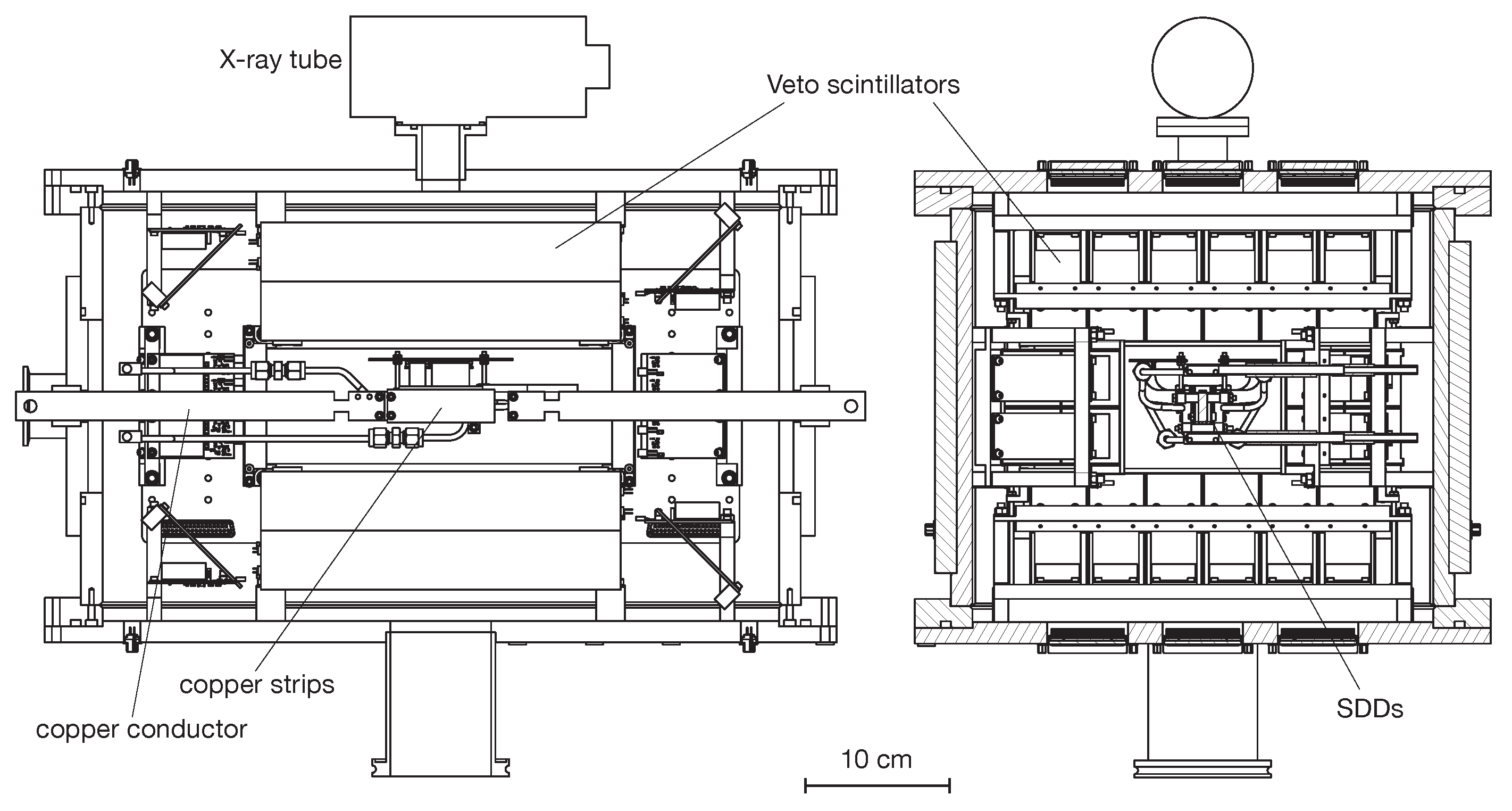VIP-2 —High-Sensitivity Tests on the Pauli Exclusion Principle for Electrons
Abstract
1. Introduction
2. Experimental Method of VIP-2
- the VIP experiment used Charge Coupled Devices (CCDs) as X-ray detectors, which are characterized by a Full Width at Half Maximum (FWHM) of 320 eV at 8 keV. In order to improve the energy resolution at the anomalous transition energy 7746.73 eV (see Ref. [24]), the CCDs are replaced by Silicon Drift Detectors (SDDs) with a better energy resolution (190 eV FWHM at 8 keV) [28];
- the copper target is reshaped in order to increase the acceptance for the detection of the X-rays. The new target consists of two strips of copper (with a thickness of 50 μm, and a surface of 9 cm × 3 cm);
- the circulating DC current in the copper target is also increased, in order to enhance the pool of test electrons. To this end, a cooling pad (cooled down by a closed chiller circuit) is placed in between the two strips in order to avoid the temperature rise due to the heat dissipation in copper. This allows to increment the DC current from 40 A (in VIP) to 100 A;
- the timing resolution of the SDDs allows the implementation of a veto system which works as an active shielding, reducing the background originating from the high energy charged particles that are not shielded by the rocks of the Gran Sasso mountains. It is made of 32 plastic scintillators, each of size 250 mm × 38 mm × 40 mm, read from both sides by silicon photomultipliers.
- all the detectors and the front end preamplifier electronics are mounted inside the vacuum chamber which is kept at about 10−6 mbar during operation;
- the energy calibration and the measurement of the SDDs resolution is performed by means of a weakly radioactive Fe-55 source, with a 25 μm thick titanium foil attached on top, mounted together inside an aluminum holder. The fluorescence X-rays from titanium and manganese are used to calibrate the digitised channel into energy scale.
3. Data Analysis
4. Conclusions and Outlook
Author Contributions
Funding
Acknowledgments
Conflicts of Interest
Abbreviations
| VIP | Violation of Pauli |
| VIP-2 | Violation of Pauli-2 |
| INFN | Istituto Nazionale di Fisica Nucleare |
| PEP | Pauli Exclusion Principle |
| SP | Symmetrization Postulate |
| QFT | Quantum Field Theory |
| SST | Spin Statistic Theorem |
| MG | Messiah–Greenberg |
| LNGS | Gran Sasso National Laboratory |
| DC | Direct Current |
| CCD | Charge Coupled Devices |
| FWHM | Full Width at Half Maximum |
| SDD | Silicon Drift Detector |
| ROI | Region of Interest |
| probability distribution function |
References
- Pauli, W. On the connexion between the completion of electron groups in an atom with the complex structure of spectra. Z. Für Phys. 1925, 31, 765. [Google Scholar] [CrossRef]
- Kaplan, I.G. The Pauli Exclusion Principle and the Problems of Its Experimental Verification. Symmetry 2020, 12, 320. [Google Scholar] [CrossRef]
- Hilborn, R.; Tino, G. Spin-Statistics Connection and Commutation Relations: Experimental Tests and Theoretical Implications, Anacapri, Capri Island, Italy, 31 May–3 June 2000; AIP Conference Proceedings; American Institute of Physics: Melville, NY, USA, 2000. [Google Scholar]
- Curceanu, C.; Gillaspy, J.; Hilborn, R.C. Resource letter SS–1: The spin-statistics connection. Am. J. Phys. 2012, 80, 561–577. [Google Scholar] [CrossRef]
- Pauli, W. The Connection Between Spin and Statistics. Phys. Rev. 1940, 58, 716–722. [Google Scholar] [CrossRef]
- Lüders, G.; Zumino, B. Connection between spin and statistics. Phys. Rev. 1958, 110, 1450. [Google Scholar] [CrossRef]
- Messiah, A.M.L.; Greenberg, O.W. Symmetrization Postulate and Its Experimental Foundation. Phys. Rev. 1964, 136, B248–B267. [Google Scholar] [CrossRef]
- Gentile j, G. Itosservazioni sopra le statistiche intermedie. Il Nuovo Cimento 1940, 17, 493–497. [Google Scholar] [CrossRef]
- Greenberg, O. Interactions of particles having small violations of statistics. Phys. A Stat. Mech. Appl. 1992, 180, 419–427. [Google Scholar] [CrossRef]
- Green, H.S. A generalized method of field quantization. Phys. Rev. 1953, 90, 270. [Google Scholar] [CrossRef]
- Dell’Antonio, G.; Greenberg, O.; Sudarshan, E. Group Theoretical Concepts and Methods in Elementary Particle Physics; Lectures at the Istanbul Summer School of Theoretical Physics; Gürsey, F., Ed.; Gordon and Breach: New York, NY, USA, 1964; p. 403. [Google Scholar]
- Fermi, E. Le Ultime Particelle Costitutive Della Materia. Scientia 1934, 28, 21. [Google Scholar]
- Milotti, E. Enrico Fermi’s view of identical particles. arXiv 2007, arXiv:physics.hist-ph/0705.1363. [Google Scholar]
- Govorkov, A. The existence of antiparticles seems to forbid violations of statistics. Phys. A Stat. Mech. Appl. 1994, 203, 655–670. [Google Scholar] [CrossRef]
- Ignatiev, A.Y.; Kuzmin, V. Is small violation of the Pauli principle possible? In Quarks ’86: Proceedings of the Seminar, Tbilisi, USSR, 15–17 April 1986; Tavkhelidze, A.N., Matveev, V.A., Pivovarov, A.A., Tkachev, I.I., Eds.; VNU Science Press BV: Utrecht, The Netherlands, 1987; pp. 263–268. [Google Scholar]
- Ignatiev, A.Y. X rays test the Pauli exclusion principle. Radiat. Phys. Chem. 2006, 75, 2090–2096. [Google Scholar] [CrossRef]
- Greenberg, O.W.; Mohapatra, R.N. Local Quantum Field Theory of Possible Violation of the Pauli Principle. Phys. Rev. Lett. 1987, 59, 2507–2510. [Google Scholar] [CrossRef] [PubMed]
- Okun, L.B. Possible violation of the Pauli principle in atoms. JETP Lett. 1987, 46, 420–422. [Google Scholar]
- Amado, R.D.; Primakoff, H. Comments on testing the Pauli principle. Phys. Rev. C 1980, 22, 1338–1340. [Google Scholar] [CrossRef]
- Arzano, M.; Kowalski-Glikman, J. Deformed discrete symmetries. Phys. Lett. B 2016, 760, 69–73. [Google Scholar] [CrossRef][Green Version]
- Addazi, A.; Marcianò, A. A modern guide to θ-Poincaré. arXiv 2018, arXiv:1811.06425. [Google Scholar]
- Balachandran, A.P.; Govindarajan, T.R.; Mangano, G.; Pinzul, A.; Qureshi, B.A.; Vaidya, S. Statistics and UV-IR mixing with twisted Poincaré invariance. Phys. Rev. D 2007, 75, 045009. [Google Scholar] [CrossRef]
- Ramberg, E.; Snow, G.A. Experimental limit on a small violation of the Pauli principle. Phys. Lett. B 1990, 238, 438–441. [Google Scholar] [CrossRef]
- Shi, H.; Milotti, E.; Bartalucci, S.; Bazzi, M.; Bertolucci, S.; Bragadireanu, A.; Cargnelli, M.; Clozza, A.; De Paolis, L.; Di Matteo, S.; et al. Experimental search for the violation of Pauli exclusion principle. Eur. Phys. J. C 2018, 78, 319. [Google Scholar] [CrossRef]
- Curceanu, C.; De Paolis, L.; Di Matteo, S.; Di Matteo, H.; Sperandio, S. Evaluation of the X-Ray Transition Energies for the Pauli-Principle-Violating Atomic Transitions in Several Elements by Using the Dirac-Fock Method; Technical Report; LNF Preprint, INFN-13-21/LNF, 21-11-2013; SIDS-Pubblicazioni Laboratori Nazionali di Frascati: Frascati, Rome, Italy, 2013. [Google Scholar]
- Ignatiev, A.Y.; Kuzmin, V. Search for slight violation of the Pauli principle. JETP Lett. 1987, 47, 6–8. [Google Scholar]
- Curceanu (Petrascu), C.; Bartalucci, S.; Bertolucci, S.; Bragadireanu, M.; Cargnelli, M.; Di Matteo, S.; Egger, J.P.; Guaraldo, C.; Iliescu, M.; Ishiwatari, T.; et al. New Experimental Limit on the Pauli Exclusion Principle Violation by Electrons—The VIP Experiment. Found. Phys. 2011, 41, 282–287. [Google Scholar] [CrossRef][Green Version]
- Quaglia, R.; Bombelli, L.; Busca, P.; Fiorini, C.; Occhipinti, M.; Giacomini, G.; Ficorella, F.; Picciotto, A.; Piemonte, C. Silicon Drift Detectors and CUBE Preamplifiers for High-Resolution X-ray Spectroscopy. IEEE Trans. Nucl. Sci. 2015, 62, 221–227. [Google Scholar] [CrossRef]
- Milotti, E.; Bartalucci, S.; Bertolucci, S.; Bazzi, M.; Bragadireanu, M.; Cargnelli, M.; Clozza, A.; Curceanu, C.; De Paolis, L.; Egger, J.P.; et al. On the Importance of Electron Diffusion in a Bulk-Matter Test of the Pauli Exclusion Principle. Entropy 2018, 20, 515. [Google Scholar] [CrossRef]
- Kittel, C. Introduction to Solid State Physics, 7th ed.; Wiley: New York, NY, USA, 2007. [Google Scholar]
- D’Agostini, G. Bayesian Reasoning in Data Analysis: A Critical Introduction; World Scientific: Singapore, 2003. [Google Scholar]



Publisher’s Note: MDPI stays neutral with regard to jurisdictional claims in published maps and institutional affiliations. |
© 2020 by the authors. Licensee MDPI, Basel, Switzerland. This article is an open access article distributed under the terms and conditions of the Creative Commons Attribution (CC BY) license (http://creativecommons.org/licenses/by/4.0/).
Share and Cite
Piscicchia, K.; Marton, J.; Bartalucci, S.; Bazzi, M.; Bertolucci, S.; Bragadireanu, M.; Cargnelli, M.; Clozza, A.; Del Grande, R.; De Paolis, L.; et al. VIP-2 —High-Sensitivity Tests on the Pauli Exclusion Principle for Electrons. Entropy 2020, 22, 1195. https://doi.org/10.3390/e22111195
Piscicchia K, Marton J, Bartalucci S, Bazzi M, Bertolucci S, Bragadireanu M, Cargnelli M, Clozza A, Del Grande R, De Paolis L, et al. VIP-2 —High-Sensitivity Tests on the Pauli Exclusion Principle for Electrons. Entropy. 2020; 22(11):1195. https://doi.org/10.3390/e22111195
Chicago/Turabian StylePiscicchia, Kristian, Johann Marton, Sergio Bartalucci, Massimiliano Bazzi, Sergio Bertolucci, Mario Bragadireanu, Michael Cargnelli, Alberto Clozza, Raffaele Del Grande, Luca De Paolis, and et al. 2020. "VIP-2 —High-Sensitivity Tests on the Pauli Exclusion Principle for Electrons" Entropy 22, no. 11: 1195. https://doi.org/10.3390/e22111195
APA StylePiscicchia, K., Marton, J., Bartalucci, S., Bazzi, M., Bertolucci, S., Bragadireanu, M., Cargnelli, M., Clozza, A., Del Grande, R., De Paolis, L., Fiorini, C., Guaraldo, C., Iliescu, M., Laubenstein, M., Miliucci, M., Milotti, E., Napolitano, F., Pichler, A., Scordo, A., ... Curceanu, C. (2020). VIP-2 —High-Sensitivity Tests on the Pauli Exclusion Principle for Electrons. Entropy, 22(11), 1195. https://doi.org/10.3390/e22111195






